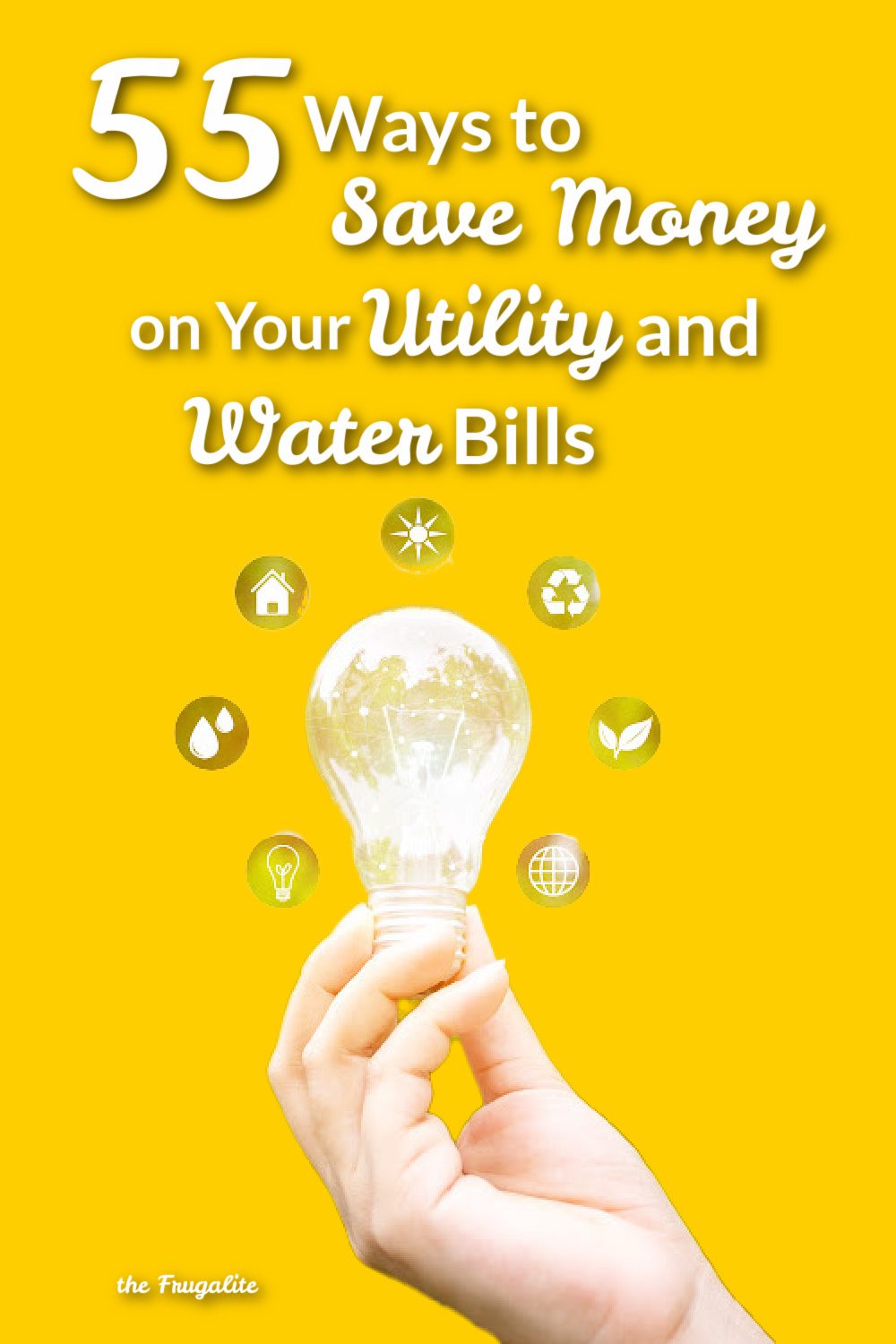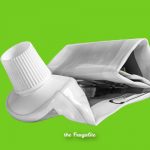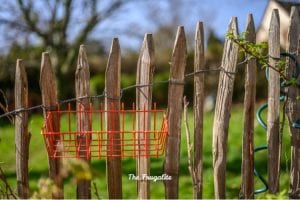(Psst: The FTC wants me to remind you that this website contains affiliate links. That means if you make a purchase from a link you click on, I might receive a small commission. This does not increase the price you’ll pay for that item nor does it decrease the awesomeness of the item. ~ Daisy)
Guest post by the author of The Dirty Truth About Homesteading and The Prepper’s Yearbook.
Who doesn’t want to save money on utility and water bills? After all, those are the single biggest expense for most households. Sometimes those two bills combined are more expensive than the mortgage. Sometimes those two bills are the same as the mortgage and monthly groceries. In other words, they are just expensive.
In the twenty plus years of paying for a utility bill and growing up in a house that was very conscious of its water and electrical use, I have learned some tips and tricks to drive down the costs of those bills. Some of these tips will not cost you a thing and will provide immediate results. Some results will not be immediately seen. For some of these tips, you will need to pay to save. You will need to purchase items will that will pay for themselves in the future.
I realize some towns/cities/companies have minimum usages for utilities and water. If you are above the minimum usages, you want to get down to those if you can. You can also call and try to negotiate the minimum usage amount, but most places do not allow that.
55 Ways To Save Money on Utility and Water Bills
1. Shut off the lights. Most houses are lit up like they are a light show. If you are not in the room, shut off the lights. Use lamps, oil lamps, or candles instead of overhead lights to save money. During the day, use natural lighting.
2. Unplug the small appliance especially the ones with lights or a display. They draw power even though they are not in use.
3. Hang your laundry instead of using the clothes dryer. You can hang inside or outside depending on your weather. Hanging inside during the winter also provides some needed humidity too if you live where it is cold.
4. Plant trees to shade your home. Tree shade keeps a home cooler and is better for the environment.
5. Fix your leaking faucets. You lose a lot of water with a leaking faucet. If you have well water, you are losing electricity too by keeping the well pump running.
6. Use low flow showerheads. These also help save money and you still have good water pressure for a great shower.
7. Clean or replace the faucet aerators (screen on the end of your faucet) to use less water.
8. Replace old dying appliances with new (or newer) energy efficient ones.
9. Use your grill or firepit to cook a meal instead of the stove.
10. Have a no television, no electronic times of the day. Extend this further by having a no television week every month. Not having the television on will save money and using electronics less will save on charging times.
11. Plastic on the windows during the winter to cut down on drafts and keep the house warmer.
12. Set the thermostat lower in the winter and higher in the summer when you are gone from the home.
13. Set the thermostat two degrees lower than usual in the winter and two degrees higher than usual in the summer to save money.
14. Get an energy audit done by your local utility company. They will tell you where you can make changes and often you get a free kit for the having the audit done. The audit isn’t always free though.
15. Turn down the water heater to 120 degrees or lower yet. You can still take a hot shower with 120-degree water.
16. Set a timer for showers. Most people do not need more than ten minutes for a shower. Teenagers seem to forget this so set a timer.
17. Only flush your toilet every 2-3 trips. You know the saying, “If it is yellow, let it mellow. If it is brown, flush it down.” You do not need to flush the toilet every time you pee. Worried about pets or toddlers? Use a toilet lid lock so they can not get into the toilet.
18. Put a brick covered in plastic wrap in the toilet tank to reduce the amount of water needed to flush.
19. Have a leaky toilet? Replace the seal, replace the float, and/or replace the toilet. If you are replacing the toilet, definitely spend the money for the low flow toilets. Most of those toilets use less than two gallons of water per flush.
20. Save the warm-up water from your showers. You can use this normally wasted water for flushing toilets (shut off the water to the toilet first) or watering plants.
21. Check your water heater. Have the water heater serviced or learn how to service it yourself. Flush the water heater out once a year to remove sediment. If it is over 20 years old, consider replacing it with a tankless water heater or something much more energy efficient.
22. Warm your water heater with an insulated blanket if it is in an unheated basement or room to reduce heat loss from the tank. You can also wrap the pipes coming from the water heater to prevent heat loss further which causes your water heater to work harder.
23. Set up a rain catchment system. Catching rainwater to use for watering lawns and plants is certainly going to save you a lot of money. Some cities/townships/counties/states do not allow for this practice so check your local laws. You may need to have it flow into hidden tanks if you want to do this.
24. Check the seals on your doors. You can lose a lot of hear/air from doors that are not properly sealed. Replace the seals if you can. If they are doors you do not use, seal them off completely.
25. Close off rooms you do not use. Unless there are pipes in those rooms, you can shut off those rooms. Close off the heat vents and close the door. You can always open them back up and turn the vent on again if you need to use those rooms.
26. Switch out any old electrical plug-ins and light switches. Most of them become weak over time and do not securely hold the plugs in right.
27. Use thermal lined or insulated curtains to keep rooms cool or warm depending on the season.
28. Use solar power whenever possible. You may not be able to purchase a large system, but you can take advantage of solar chargers or small solar panels to run small appliances.
29. Use a wood stove or a wood cookstove instead of electric or gas to keep your home warm and cook your meals. Some insurances do not allow wood stoves so you will need to check into this and maybe switch insurance companies.
30. Fill your sink with water when washing dishes. Fill one side or a tub with wash water and the other side with rinse water. You waste more water by running the faucet than you do with just filling the sink.
31. Use draft stoppers on doors. If you do have a bad seal on a door or an inside door leading to an unheated area, you can make or purchase a draft stopper to seal off the door better.
32. Wear more clothes in the winter and fewer clothes in the summer. Most people do not want to be uncomfortable. However, you can add layers of clothes in the winter to keep the heat bill down. There is also nothing wrong with wearing a fleece jacket, stocking cap, and fingerless gloves inside the house in the winter.
33. Add more blankets to beds in the winter to keep the heat down overnight.
34. Only shower every other day if you can. A good deal of people do not need to shower every day. Most kids under the age of twelve only need to shower or bath 2-3 times a week. Most people just do not get dirty enough or gross enough to shower every day. However, if you do get really dirty and/or sweaty every day, shower. If you have an illness in the house, please shower or bath as often as possible.
35. You do not need to wash your bedding every week. Save your water bill and wash your bedding every 2-3 weeks. If you are worried about the sheets being gross, shower before bedtime or sleep on a towel.
36. Only run full loads of dishes in the dishwasher and full loads of laundry in the washing machine. With most washing machines, you can at least adjust the level load to keep the water usage down. However, you will save money on your electrical bill by only running these machines with full loads.
37. Kids do not need a full bathtub to get cleaned. Save your water bill some more by only using no more than five inches of water in the bathtub. If they are toddlers or preschoolers, you can use even less water.
38. Keep rooms clean and uncluttered. If the rooms are dirty and cluttered, they will take more energy to heat because they are trying to heat your stuff too.
39. If you are using the oven, try cooking multiple things in the oven at the same time to conserve power. If you are baking a casserole, plan to bake bread or bars at the same time. You can also put potatoes or vegetables into roast for another meal.
40. Have blankets available to use and cover-up. You can keep the heat lower while everyone is just sitting in the living room watching television.
41. Wear clothes more than once to keep your laundry down and use less water. Most of our clothing can be worn more than once (yes, undergarments are the exception). Unless you get gross and dirty, you can wear clothes at least twice if not more. You can wear the same pair of pajamas all week.
42. Open your windows instead of using the air conditioner. Most people need to air out their homes on a regular basis anyway. Unless you live in a really dirty area or have severe allergies, you should be opening your windows to save money.
43. Look for opportunities to shut off your heat or air conditioning. Unless it is really humid or hot (over 85 degrees), I keep the air conditioner shut off and will open the windows if I can. The heater gets shut off if the outside temp is over 60 degrees during the fall, winter, and spring. Most of the time, the heater will not run anyway because the inside temp will stay over 65 degrees during the day, but I like to shut it off and see how long we can go before turning it on. Once the inside temp drops below 58 degrees, I will turn it back on.
44. Are you using a small appliance for something you can do easily by hand? You can really nit-pick here, but you could use a manual can opener inside of an electric one. You can use a whisk instead of an electric mixer. The list goes on, but you are trying to save money. The little savings add up too.
45. If it is winter, keep moving. In the winter, we tend to get colder because we sit more. We naturally want to hibernate or do as little as possible. However, to keep your body heat up and the thermostat turned down, you need to keep moving. You can deep clean a room, clean house daily, and more. Just keep moving around. Here are more tips on staying warm using less heat.
46. If it is summer, consider energy conservation for yourself. In the summer, we tend to do things that make us hot and sweaty which causes us to turn the thermostat lower to stay cooler. Keep the heavy work for morning or late afternoon/evening. If you feel the need to heavy, sweaty work during the day, consider a cool shower or even an outdoor solar shower bag to cool off instead.
47. In the summer, cook outside or eat cool meals. Heating up the house will make us want to adjust the thermostat. Keep the cooking outside if you can. If you are a canner or caterer, consider installing an outdoor kitchen to keep the heat outside.
48. Unplug electronic devices after they are done charging. Most chargers still keep drawing power after they are done charging. Unplug them or put them on a power strip you can shut off so they are not drawing power anymore.
49. Use slow cookers, toaster ovens, and electric skillets instead of using your stovetop or oven. They use considerably less energy than a stovetop or oven.
50. Replace your standard light bulbs with a CFL or a LED bulb. Some bulbs are better than others, but all of them will save you money over the incandescent bulbs. I will say this: from experience, it is far better to invest money in the LED bulbs and get a better quality for better lighting. Going with cheap bulbs will more than likely result in less quality lighting.
51. Consider changing your outdoor lighting to LED or solar lights. We also use dusk to dawn lights and motion sensor lights. We replaced and added a good deal of our outdoor lights last year with no impact on the utility bill because we choose LED and solar lights.
52. If your furnace or central unit is over 20-25 years old, consider replacing it. The newer systems use considerably less energy and have many more options to make them a better fit for your home.
53. Insulate your attic. A contractor friend told me one time that most people could save a lot of money if they would just insulate their attics. A lot of homes have uninsulated attics and lose a lot of heat through those attics. Make sure you have at least 8-12 inches of insulation on your attic floor to keep the heat escaping through your roof. Be sure to check your insulation every few years because it can settle and collapse.
54. Borrow and use a kill a watt monitor and find out if you have any appliance or electronics that are sucking power without you being aware of how much. You would be surprised how much aquariums and dishwashers use.
55. Consider replacing your thermostats. After a time, they become unreliable and could be heating your house or rooms warmer than they should be. We replaced one a year ago after realizing that the room seemed very warm. Using a thermometer, we discovered the room was really almost 80 degrees instead of the 65 degrees the thermostat was set at. Every year, you should be checking to see if they are accurate by using a thermometer and checking the temperature.
Do What You Can. Every Little Bit Helps.
This is just some of the ways you can save money on your utility and water bills. Some of these may be too extreme for some of you and that is okay. Some of these may cost too much money for you now to implement them. That is okay too. Just take care of them when you have some money saved up.
There are many, many more ways to save money on your utility and water bills too. What are your best money saving ideas? Share them in the comments section!
Erica Nygaard is the author of The Dirty Truth About Homesteading and The Prepper’s Yearbook. You can read more from her on her website: Living Life in Rural Iowa, where this post was originally published.












15 thoughts on “55 Ways To Save Money on Utility and Water Bills”
All LED light bulbs here for several years. They really made a difference.
The unit that records tv programs from Satelite runs all the time. I have it on a bar that can be turned off at night when nothing I want is on programing anyway.
I keep the refrigerator freezer full or nearly full.
My propane stove oven lighter unit hasn’t worked in years. I leave it unplugged. I light the burners with a long lighter. Months of use from a $.99 lighter is cheaper than the electrionic burner lighters. And it saves LP gas over the older stoves with a pilot light.
My LP gas waterheater is set on medium. Low is too cool for showering. High is way too hot.
Summers we cook outside over a wood fire. Winters I cook on the heat collector of the rocket stove heater.
I have a lovely stacked set of washer and LP dryer but I’ve never moved the dryer in here. I have 3 folding racks. Summer and winter those work wonderfully well. The money saved with a month or two of laundry bought nice metal folding racks that have lasted for years.
We use extra bedding in winter. Many summer nights a simple sheet is plenty. We don’t have any cooling beyond 2, little 7″ fans and windows and doors open all day on the sides away from the sun. I close the doors at night. In town I might not leave them open in the daytime. My windows and storm windows have built in locks and extra glass storm layers to hold in heat. There are storm doors on both outside doors. In town I’d have added the heavy duty security screen doors.
I use $.97 cheap solar path lights both inside at windows and outside along pathways. On house corners and other out buildings I have solar motion lights. I even set up a solar motion sensor light in the room with my rabbits with the solar panel outside. A 1/8″ hole with cIear silicone sealing it was the drilled path for the connecting wire. I walk in and there is light as long as I’m moving or wave my hand. I have one dusk to dawn security light on a big shop building where it illuminates the driveway. On the entry driveway I even have a motion sensor alarm that sounds in the home.
Most things with batteries use AA or AAA size batteries. For those I purchased rechargeables and small 4, 4 battery size solar chargers.
For a reading nook I have a reconditioned car 12v battery, a cheap solar trickle charger, and small bright 12v lights salvaged from a totaled car. I also have a little 12v defrost heater/fan with heat off and on switch. Nice in the nook. I have an inverter that could be a used there but I’ve found so many 12v items that I don’t need the inverter. If I want it, I could even use a car radio and CD player. I may add a CB radio and antenna to my nook as well. I power the nook on all solar. I have an extra lighter socket that could be added in. My phone could charge there. It’s fun planning and working on such things.
I hope to get whole home power on a new solar array or I may just keep adding smaller one room set ups and not go so large in any spot. No big screen tvs here. I do own a 12″ with built in DVD, a 19″ screen I used in an art teaching studio and a 34″ TV a son gave us for the livingroom. Any or all could be used. My son gave me a roof mounted tv antenna set up on a tall pipe. I need to move it over from where we first camped on the property.
I sort of make it a game to find new ways to save money and do more. It makes it fun.
#25 closing off rooms. Living in several areas of Florida with central air we have been told by 3 different AC companies that with our systems, closing off rooms does not generate any savings. The only way is to close off the air duct before it reaches the room. To do this would require making an access in the ceiling where the duct work branches off. Better to adjust the thermostat to the highest for AC and lowest for heat that you can tolerate. Fans in the summer and extra clothes in the winter work exceeding well.
For a wood stove (propane gas heater) it is well worth closing all doors to rooms not used.
I have 3 bedrooms, a lavatory, a laundry, one bathroom, and a storage room that don’t need heating.
That’s half my house!!!
Those are great savings to not have that heater kick on twice as often.
I had ancestors who grew up on rural homesteads in the pre-electric era when people heated bath water on wood-fired kitchen stoves. I still have one of those ancient copper-sided long-sided boiler tubs that spread over two burners simultaneously.
Another strategy is to learn and practice the 3rd world method of taking a bucket bath. Heat one bucket full of water to about 120° F and use a couple of sponges, one without and one with a scruffy side. Hospitals today often force patients they fear might be a slip-and-fall risk to take such baths while sitting down. At home the equivalent might be sitting on an upturned bucket (with a foam pad, cut to size, as a cushion — that your bottom will appreciate) in your tub or even in a large storage container anywhere else (if for example, your tub is occupied with a full Water BOB). You’ll use much less water than showering, and the bucket bath method works really well even when traveling… for which there are tents made just for bathing and toileting.
Back to the kitchen. If there had been insulated kitchen gloves such as the Spontex brand of “Bluette” gloves in multiple sizes, the dishwasher salesman in the late 1800s would have had a much tougher time selling their new gadget. I turned off my dishwasher many years ago, and with a glove on one hand and a scrubber (in the other hand) cut down from a never-ever-used toilet brush (the handle cut down to about 8 inches), I haven’t found anything I couldn’t wash quickly in a little soapy hot water. One glove will easily last 2-3 years before I have to replace it with its mate — and simply switch hands to carry on. Amazon sells them so you can have backups.
People in the pre-electric era heated dishwater on their wood stoves as well. Today not only do you have a choice of heating water on your kitchen stove, there’s also the option, in a power outage, eg., to heat water on almost any kind of outside burner (whether wood fired, propane, butane, solar, or whatever) or indoors if you have decent ventilation over your stove. One non-obvious method is to cook over rising steam. The lowest pot rests on whatever type (and location) of burner you have, the 2nd pot with steaming holes nests neatly over that boiling pot, and if you’re being really economical / frugal / cheap / lazy …, put a 3rd nesting pot above #2 to heat it up instead of dirtying another dish or bowl to eat out of.
Some cookware sets come with at least one nesting pot with steamer holes in its bottom. Some don’t but are often suitable to use a drill or drill press to cut such holes. I have examples of both.
FYI. Steam cooking doesn’t leave the mess to clean up like frying, or anything else that leaves a stubborn residue to clean off. Economy of effort has its own virtues. Oh, the French and Chinese cookbooks about steam cooking are some of the best in the world.
The water you used to steam-cook that one-pot meal can also then serve as the dishwashing water …. which works best if you leave a lid on it until you’re ready to wash up. Otherwise you might have to re-heat it a little bit.
Do you see why that 55-gallon (or so) water heater in your garage (or wherever) may better serve as extra water storage in an emergency — instead of wasting that water in so many ways? Obviously the fewer people in your household, the easier such s strategy becomes.
And to recap, this methodology works equally well at home, during long term power outage emergencies, or for traveling whether for short trips or even full-fledged nomadic living.
Regarding doing laundry, these days most (not all) clothes last longer when washed in cold water using cold water compliant detergents, whether sold at retail (like ALL at Walmart) or DIY. A muscle-powered plunger in one bucket with water and detergent plus a second bucket with cold water only in it for rinsing eliminates the need for heating up water and eliminates the need for electric power to run a washer. (A hand-crankable wringer used before the rinse bucket helps a lot.) And a clothes line or drying rack cancels the need for running the dryer. Think … long term power outage implications.
–Lewis
The average toilet nowadays flushes a maximum of 1.6 gallons (mine has two buttons on top, 1.0 for pee, 1.6 for the heavy stuff). We always flush because leaving it makes a toilet harder to clean. If you don’t have a newer toilet, get one. It will pay for itself.
Spend a few extra bucks and skip the CFL bulbs. Go directly to LEDs. Why? They last longer. You need to replace CFLs every 18 months or so (as I remember). We’ve had LEDs in the house since we’ve rebuilt it (wrecked after Hurricane Harvey) and haven’t replaced one. They do use about 3/4s the amount of power a CFL does, and about 1/7th the amount an incandescent light uses.
Turning the water heater down too low can cause dangerous bacteria to get in your tank and pose health hazards to you when you shower, use the water to wash dishes with etc. So this is really bad advice. NEVER go lower than 120F as lower temperatures than this can increase the risk of Legionnaires Disease
This company has a couple of gadgets they claim will significantly reduce your power bill. Stop Watt was the one I saw advertised. I see they’ve added a similar item as well:
https://powerwattwise.com/product-stopwatt.html
There are a few competitors as well so an online search can be interesting.
The mention of using solar energy didn’t include a couple of major possibilities. Since there are about five major design categories … with near countless variations for each category …. you can choose whether to buy or DIY build (dirt cheap) many of those possibilities. The cheapest solar panel cooker I ever built (Copenhagen design) cost a little under $10 in materials. I have a couple of huge Fresnel lenses (which will make powerful solar cookers/heaters) which I got for free when neighbors set out their giant rear projection TV sets for trash pick-up. The All Season Solar Cooker is a panel cooker running about $107. However the Sun Oven is a lot more pricey … at $545 this morning on Amazon. Sadly one like that was stolen from a friend of mine a couple of years ago by her house-cleaning crew.
You can use solar energy to cook, to heat water, to distill water, etc as a way to conserve on power you have to pay for. Some solar cookers (called hybrids) have a built-in electrical backup heater so if the sun becomes suddenly overcast or your cooking process needs to continue after the sun goes down … you can instantly switch over and finish your recipe without missing a beat. There is a book on Amazon by Sharon Buydens about how to make your own solar distiller … that many families along the southern US border with Mexico use since local politicians refused to clean up local water supplies otherwise. That’s a solution that can clean up any kind of contaminated water whether it came off your roof or a local pond or horribly contaminated flood waters … even if a long term power outage gets in your way.
Some of my ideas are much easier for either a lone wolf or just a couple of people. I turned off the gas, the HVAC system, and the central water heater completely years ago. I only need to wash dishes (by hand) once a day. Washing once for both breakfast and supper ware (after supper) removes part of the need for hot water 24/7. The other part is handled by a sponge bath where a bucket’s worth of water is heated to 120°F via stove or other electric burner. If there is a long term power outage … there are always a rocket stove or a solar energy heating option. BTW if you keep propane handy to fire up a camp stove … be aware some some house insurance companies require that you store your propane at least 30 feet or more outside and away from your house. In the event of a house fire … if the insurance inspector learns that you stored propane closer to your house (or worse inside) than the minimum distance mandated in the fine print of your policy, the company can use that as an excuse NOT to pay you for your damage even if your stored propane was not involved in the damage. The potential savings to you in such an ugly event could be enormous.
If you dress more like an Indian in the summer time and more like an Eskimo in the winter … you can get by nicely without central heating and cooling completely. In the summer small fans work well and in the winter small portable electric heaters are sufficient. No HVAC addition to the bill at all.
So what options are available for keeping water pipes from freezing up in wintertime? There are a couple of non-powered gadgets available on Amazon called Freeze Miser. I have one for the outside front water faucet and one for the rear. When the outside temperature drops into the danger region (a little above freezing) both devices sense that and began a steady drip … until the outside temperature climbs back into reasonable levels again. When there is a risk of freezing … I manually set the indoor faucets to a light drip until the threat goes away. Much cheaper than depending on an indoor heating bill and more reliable than an electric heater for both outdoor faucets (especially if a sudden power outage surprises everybody.
I unplugged my large screen television a couple of decades ago when the quality began to disgust me. I use small very portable radios that have not only AM and FM but also NOAA and shortwave capabilities. The huge advantage is that I can listen where ever I want to … while doing other things … instead of being hand-cuffed to the TV with repulsive programming. Also those radios use rechargeable and replaceable batteries for which I have both AC and solar chargers.
Regarding the “if its yellow, let it mellow, if it’s brown, flush it down” saying.. be aware that the Amish communities (that avoid using electric power) sometimes add their human feces to the compost materials they use for gardening. Once you know .. it’s your choice. A little bit of history …after the enormous buffalo herds were killed off in the midwest … new settlers used the left-behind piles of buffalo dung to heat their new homes instead of firewood (which was largely unavailable on the great plains).
Regarding your incandescent light bulbs … DO NOT throw them away. While an EMP attack can fry your LED lights, the incandescents you stored away will not be damaged . Be aware that Dementia Biden by executive order shut down any further US sales of incandescents after August 1, 2023. So you now can only rely on ones that you have saved or ones that you might order from other countries.
–Lewis
Which is why I have a huge plastic box of bulbs bought just because they stopped making the kind I use.
I would add an attic fan to the list. Yes uses electricity to run (unless there is a solar option which is not always an option for some). But your A/C and/or house fans will run less.
If you want to use your crock pot, toaster oven, deep fryer, “George Foreman” type griddle or other heat generating appliance during warm/ho weather, try to use it outside. Am added bonus of not having the “fried fish” smell in the house.
Learn to use your gas grill for baking chores in the warm months. Yes, you’ll miss out on the aroma of your home made breads, but you won’t be heating up the house.
I would personally avoid CFLs if at all possible. Below about 45 degree F, they act pretty wonky with flickering and low output light. The prospect of heavy metals, (like mercury that was used in the past) can be found in florescent tubes is another area of possible concern.
LED lights don’t always live up to the lifespan expectations of the advertising. The issue isn’t with the LEDs themselves, but rather the electronics inside them that step the 120 volt line voltage to 6 or so volts. Then the rectifiers (diode) and capacitors needed to convert the AC to DC for the LEDs to consume. Your mileage will vary.
I meant to mention, I have an LED bulb over the kitchen sink that is on 24/7/365. The original was installed in 2014 during a big remodel job. Last week, I changed the bulb for the second time. Ever. Roughly 87,000 hours for the first two (2) bulbs. Even if I miscounted, and this was my 3rd bulb 30,000 hours or so is impressive.
Maybe the longevity was due to the light never being turned off ?
Saving money is important to me, but there are some things I won’t do, because I consider them unhygienic, counter-productive or just plain silly.
I’m absolutely going to flush the toilet every time. Every time.
Bathing is for everyday. Anything other than clean clothes is disgusting.
No LEDs for me. I actually like to see what I’m reading.
DON’T get rid of your old appliances. They are far superior to anything on the market. The new stuff is designed to break down and is really lousy.
Not only am I going to run my dishwasher every day, sometimes it’s twice a day, and if a lot of cooking is going on, 3 times. Anything else is counterproductive. Dirty kitchens lead to eating out. Overly full dishwashers don’t get the dishes clean.
Lots of the ideas in this article were okay but some of them literally stink.
Carla,
I agree with you on many of your points, including:
Modern appliances are cheaply made, mostly plastic, Chinese and 3rd world junk. The repair bills will destroy a budget. Even if you are a DIY repair person with a local appliance parts store, the costs can become HUGE.
I know of many people who can’t stand LED lights for reading. In the US, incandescent bulbs for most applications were outlawed. (Thank you big government). You can resort to florescent which I find impairs my night vision because of the high UV output, or try to find conventional bulbs on line. Many bulbs you do find are made for 110 volts, not 120. In the US, we have 120 volt electricity. The 110 volt bulbs have thinner filament wires and will burn out faster than the 120 volt bulbs.
As a crotchety 74 year old guy, please don’t get me started about low volume toilets. Two flushes of a 3 gallon toilet are needed for what a single flush of an old 5 gallon device. How is that saving water ? My next toilet will be an import (Canada ?) for that reason.
On showers, as an office guy for the 9 to 5 thing and an avid small scale farmer, I usually do a shower in the morning and again after my outside sessions. An on-demand (“tankless”) water heater is a marvel. The one I have runs about $2,000 installed. It requires an annual de-scale event to remove built up mineral deposits. This can be either a DIY or a call the plumber event. Using it is a LOT cheaper than the 30 to 50 gallon monsters.
I think the bottom line on these things is for everyone to use common sense and think long term effects on you, your family and the environment.
All the best !
Mark,
Regarding the bulbs, I’ve been able to buy enough from ebay to keep us stocked.
Toilets: we were forced to replace our toilet about 10 years ago because the porcelain on ours cracked, then broke apart. Lowe’s had one that flushes (don’t remember the maker or model) but it was expensive. I’m fairly cheap, but that was one thing I wouldn’t downgrade. When our son built his cabin, we bought him the same kind. He wanted a cheap one, but later said he was glad he got it. I, too, had considered getting a toilet from Canada.
Water: Baths are preferable to showers for me but I rarely run a full tub of water. I tested it once by filling the tub by the shower head and discovered that I was using the equivalent amount of water as a 5 minute shower. So there was no waste there.
Excellent points about appliances. I plan to save up for a Speed Queen washer for when our current one quits. This one is a Maytag and isn’t even in the same universe as the one we bought in 1987 (it lasted 27 years, and parts were no longer available). The one before this one was a GE and bit the dust after 4 years. The saleslady told us to expect it to last 2 years and even at that it was cheaper than going to the laundromat, which was true. I don’t even want to think about what’s down the road for gas stoves.
It doesn’t matter who you vote for unless you want a light you can read by, a toilet that flushes, a shower head that will get you clean, a choice in how you cook your food, etc. Ad nauseum. None of these things are any of the government’s business.
Many of the suggestions in the article don’t take into consideration the impact on the environment, for instance how many extra appliances are ending up in the landfill because they don’t work. I know people who replace theirs even more often than we do. It’s sickening to think of all that waste.
Concerning the bad hygiene advice: the nosedive in disease-caused deaths in the 20th century is due in large part because of improved sanitation. I believe that it’s no co-incidence that the globalists want to reduce the world population all the while they’re encouraging people to bathe less and stop flushing their toilets.
Many of these suggestions are repeated from article to article in print and on the internet, and I believe that some of it’s just plain bad advice.
We’re in the same age group. Nice reply. Thanks.
Lots of great suggestions here, and as usual the comments are great too! Regarding shade trees, in some areas the power company will give saplings or sell them at low cost. In Tucson they are $25 for a sapling. That’s a lot cheaper than nursery costs. So if you want a tree it can be a good way to go. Some power companies sell LED bulbs for cheaper. I just got all of mine when they periodically went on sale at the grocery store. I still haven’t had even one burn out. For those who don’t like the light, you can get full spectrum ones now that are actually pretty good. So that’s nice for those of us who like LED bulbs!